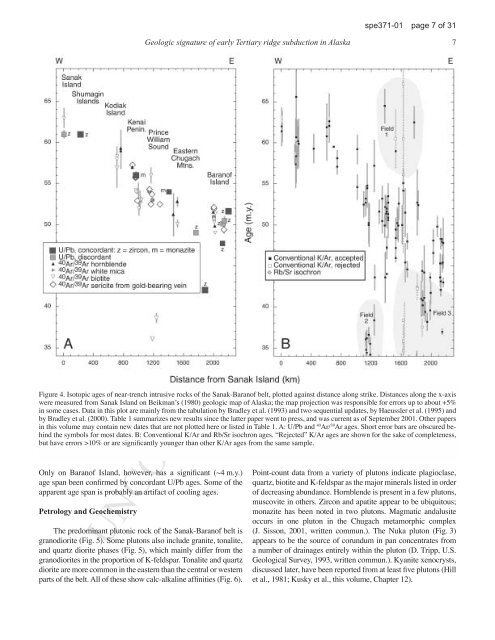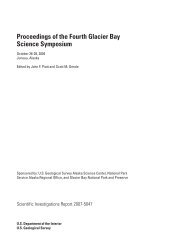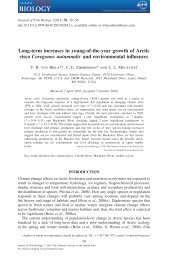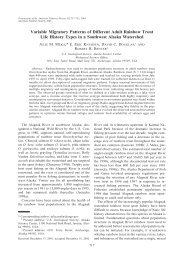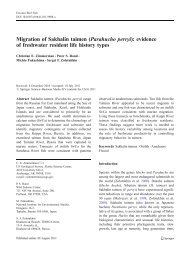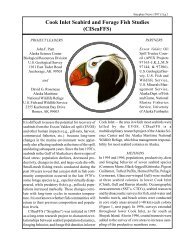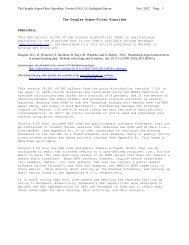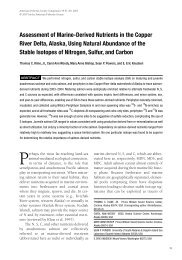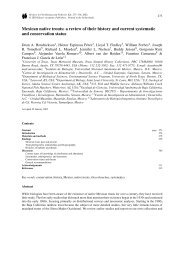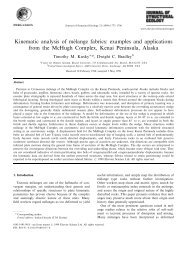UNCORRECTED PAGE PROOFS - USGS Alaska Science Center
UNCORRECTED PAGE PROOFS - USGS Alaska Science Center
UNCORRECTED PAGE PROOFS - USGS Alaska Science Center
You also want an ePaper? Increase the reach of your titles
YUMPU automatically turns print PDFs into web optimized ePapers that Google loves.
spe371-01 page 7 of 31<br />
Geologic signature of early Tertiary ridge subduction in <strong>Alaska</strong> 7<br />
Figure 4. Isotopic ages of near-trench intrusive rocks of the Sanak-Baranof belt, plotted against distance along strike. Distances along the x-axis<br />
were measured from Sanak Island on Beikmanʼs (1980) geologic map of <strong>Alaska</strong>; the map projection was responsible for errors up to about +5%<br />
in some cases. Data in this plot are mainly from the tabulation by Bradley et al. (1993) and two sequential updates, by Haeussler et al. (1995) and<br />
by Bradley et al. (2000). Table 1 summarizes new results since the latter paper went to press, and was current as of September 2001. Other papers<br />
in this volume may contain new dates that are not plotted here or listed in Table 1. A: U/Pb and 40 Ar/ 39 Ar ages. Short error bars are obscured behind<br />
the symbols for most dates. B: Conventional K/Ar and Rb/Sr isochron ages. “Rejected” K/Ar ages are shown for the sake of completeness,<br />
but have errors >10% or are signiÞcantly younger than other K/Ar ages from the same sample.<br />
Only on Baranof Island, however, has a signiÞcant (~4 m.y.)<br />
age span been conÞrmed by concordant U/Pb ages. Some of the<br />
apparent age span is probably an artifact of cooling ages.<br />
Petrology and Geochemistry<br />
The predominant plutonic rock of the Sanak-Baranof belt is<br />
granodiorite (Fig. 5). Some plutons also include granite, tonalite,<br />
and quartz diorite phases (Fig. 5), which mainly differ from the<br />
granodiorites in the proportion of K-feldspar. Tonalite and quartz<br />
diorite are more common in the eastern than the central or western<br />
parts of the belt. All of these show calc-alkaline afÞnities (Fig. 6).<br />
Point-count data from a variety of plutons indicate plagioclase,<br />
quartz, biotite and K-feldspar as the major minerals listed in order<br />
of decreasing abundance. Hornblende is present in a few plutons,<br />
muscovite in others. Zircon and apatite appear to be ubiquitous;<br />
monazite has been noted in two plutons. Magmatic andalusite<br />
occurs in one pluton in the Chugach metamorphic complex<br />
(J. Sisson, 2001, written commun.). The Nuka pluton (Fig. 3)<br />
appears to be the source of corundum in pan concentrates from<br />
a number of drainages entirely within the pluton (D. Tripp, U.S.<br />
Geological Survey, 1993, written commun.). Kyanite xenocrysts,<br />
discussed later, have been reported from at least Þve plutons (Hill<br />
et al., 1981; Kusky et al., this volume, Chapter 12).<br />
<strong>UNCORRECTED</strong> <strong>PAGE</strong> <strong>PROOFS</strong>


